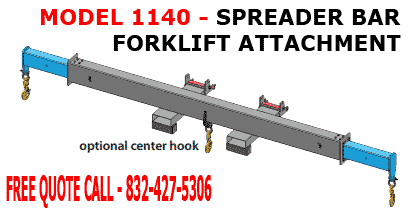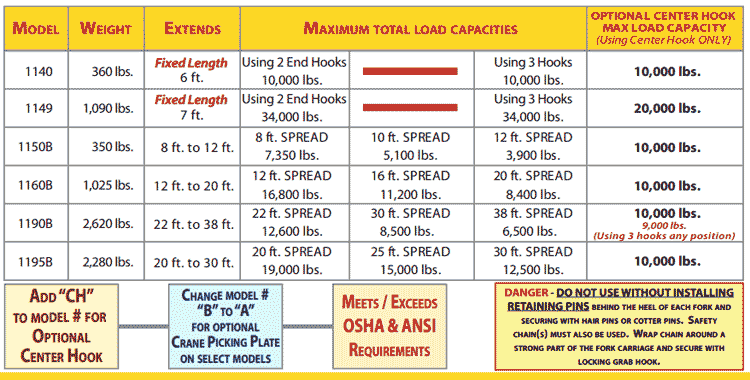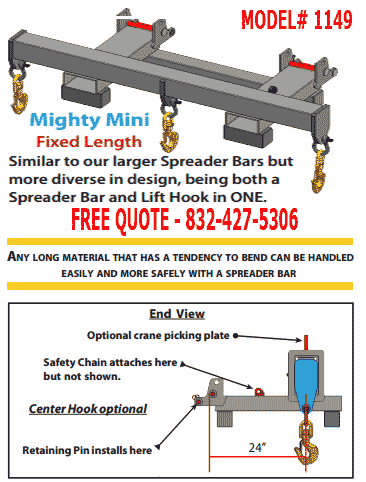FOR A FREE QUOTE CALL 888-776-3720
Model 1140 Mighty Mini Spreader Bars are designed for use on tele-handlers (extendable–reach forklifts) and straight mast forklifts as well. It comes equipped with fork pockets that will accept up to 7″ wide x 2 ½” thick forks. The design has been reviewed and carries an engineer’s stamp of approval to meet applicable ANSI standards and has been designed to 3 to 1 or better factor of safety.
The design of the industrial spreader bar attachment positions the swivel hooks at the standard 24″ load center typically found on most forklifts up to 30,000 lb. capacity. Because the lifting points are located at the 24” load center, the forklift’s standard load chart will normally apply. It is only necessary to include the weight of the attachment itself and rigging along with the weight of the load. A separate load chart or de-rating of the forklift should not be required.
 Be aware that the rated capacity of the spreader bar itself does not reflect the capacity of the Tele-handler or forklift. The total load must not exceed the capacity shown on the tele-handler’s or forklift’s load chart which will vary with make and model as well as fork and/or boom position.
Be aware that the rated capacity of the spreader bar itself does not reflect the capacity of the Tele-handler or forklift. The total load must not exceed the capacity shown on the tele-handler’s or forklift’s load chart which will vary with make and model as well as fork and/or boom position.

Use it With Confidence:
Easyrack.org has been manufacturing commercial spreader bars forklift attachments for approximately 25 years and has earned an excellent safety record. In addition, Our attachments have proven themselves repeatedly on all types of jobs all over the United States as well as in Canada, Mexico and South America.
Please be aware that the information contained in this manual is intended as a guide and does not replace the need for the user to know, understand, and observe all applicable company, local, state, and federal safety codes and/or requirements. In addition, any relevant safety requirements or recommendations contained in the forklift operator’s manual must be observed.
Before Use:
1) Make sure the operator is well qualified to operate the specific forklift model to be used, has read and understands this manual and has reviewed the forklift operator’s manual for any additional requirements, limitations, restrictions, or additional safety procedures prescribed by the forklift manufacturer when using this type of attachment. The forklift operator must also be properly certified under OSHA requirements to operate the forklift to be used.
2) Inspect the spreader bar to make sure it is in good condition. There must not be any broken welds, deformation of the steel tube or other component, nor any cracks in the
steel. Inspect swivel hooks and shackles to make sure they are complete, are in good condition, and that shackle anchor screw pins are screwed in tight. Make sure the hook latch is in place and working properly. Check to make sure the fork retaining pins have hair pins to secure them in place as well. Make sure the safety chain is properly attached and the twist lock grab hook is working properly. Check that all decals are in place and legible. The following decals are required: “Empty Weight”, “Read Before Using” and “Rated Lift Capacity. Replacement decals are available from Easyrack.org
.3) Make sure personnel involved understand any hand signals that will be required and all involved personnel understand what will be required of them.
4) Make sure the travel path is clear of obstructions and that adequate clearance will be maintained from all power lines.
Caution:
1) Risks are high for serious injury when working around suspended loads. The operator must avoid carrying the load over people and it is best to have a 10 foot clear radius. This requires that no one is allowed to be within 10 feet of the area in which the load would fall if a failure occurred.
2) Do not allow anyone to ride on the spreader bar nor on the load being carried.
3) Do not make any repairs or modifications to the spreader bar without written authorization from the manufacturer. Replacement of hooks, shackles, decals and hair-pins does not require authorization.
Installation:
On the forks installation: Insert the forks into the fork pockets and then slide the spreader bar all the way onto the forks so the pin tabs extend behind the back of the fork. Insert the fork locking pins in each side and secure them with hair-pins to lock the spreader bar to the forks. In addition secure the safety chain by wrapping the chain around a strong part of the carriage and securing it to itself with the twist Lock grab hook. Keep the chain as level as practical but do not exceed a 45 degree vertical angle.
Rated Capacities:
Rated capacities shown below also appear on the spreader bar decal(s). Be aware that these capacities are for the spreader bar itself and do not in any way reflect the capacity of the forklift. Refer to the forklift operator’s manual for capacity ratings and any limitations or restrictions when using this type of attachment. Remember the weight of the bar must be deducted from the lift capacity of the forklift. If there is any question as to the forklift’s lifting capacities when using this attachment, contact the forklift manufacturer for clarification.
Never exceed the rated capacities of the spreader bar except for purpose of a test and then do not exceed 125% of its rated capacity. Never exceed the capacity of the forklift. Make sure also that the load rating for slings, chains, or straps used with the spreader are equal to or exceed the rating of both the forklift and the spreader bar, if not; always limit the load to the lowest rated part of the lifting system.
Operation:
1) Before elevating the load, make sure the forklift mast or boom is level (vertical) – not
leaning to the right or left. Do not use the spreader bar when operating on a side slope.
2) Before the load is raised make sure slings, chains, or straps are properly secured and are not twisted around each other or entangled.
3) The load must be picked up so that it is equally balanced and hangs level.
4) When lifting a load, guard against shock loading by taking up the slack in slings or straps slowly. Prevent jerking at the beginning of the lift, and accelerate or decelerate slowly.
5) Do not use the spreader bar to drag or pull a load.
6) Do not leave suspended loads unattended.
7) Take care that the load does not swing or come in contact with an obstruction.
8) Keep all personnel clear while the load is being raised, moved, or lowered. Forklift operator should be watchful of the load at all times, especially when it is in motion.
9) Never allow more than one person to give signals to the forklift operator except to warn of a hazardous situation.
10) Never raise or carry the load higher than necessary.
RATED LOAD CAPACITY OF MODEL 1140 SPREADER BAR
Empty Weight – 360 lbs.
Using two outside hooks 10,000 lbs.
Using all three hooks 10,000 lbs.
Using Center Hook Alone 10,000 lbs. 4
11) Never allow anyone to work under a suspended load.
12) Never exceed rated capacity of any part of the lifting system.
13) Never allow anyone to ride on spreader bar or on the load being carried


Pingback: Heavy Duty Spreader Bar Forklift Attachment For Sale | VisionMasters